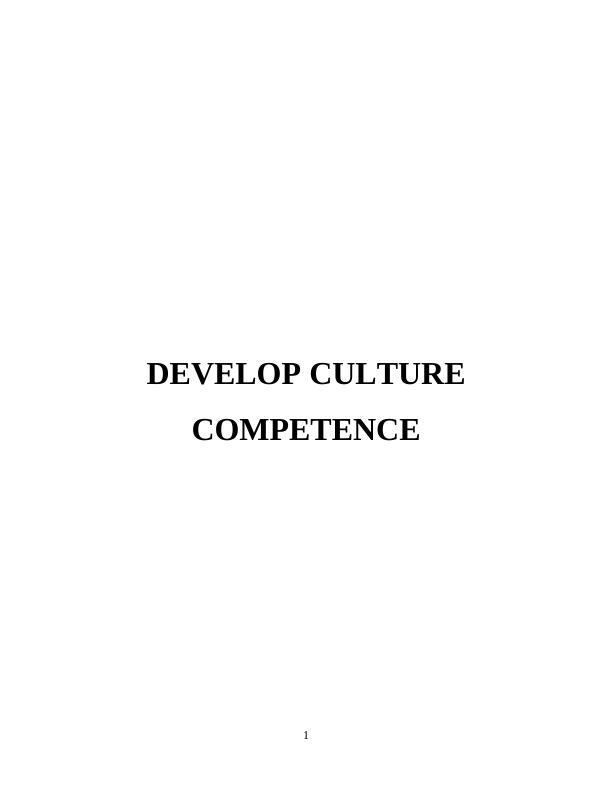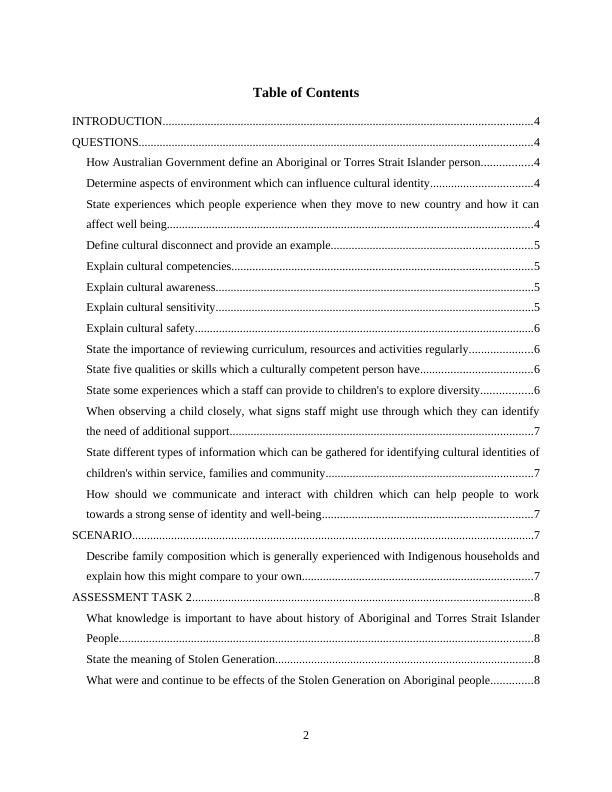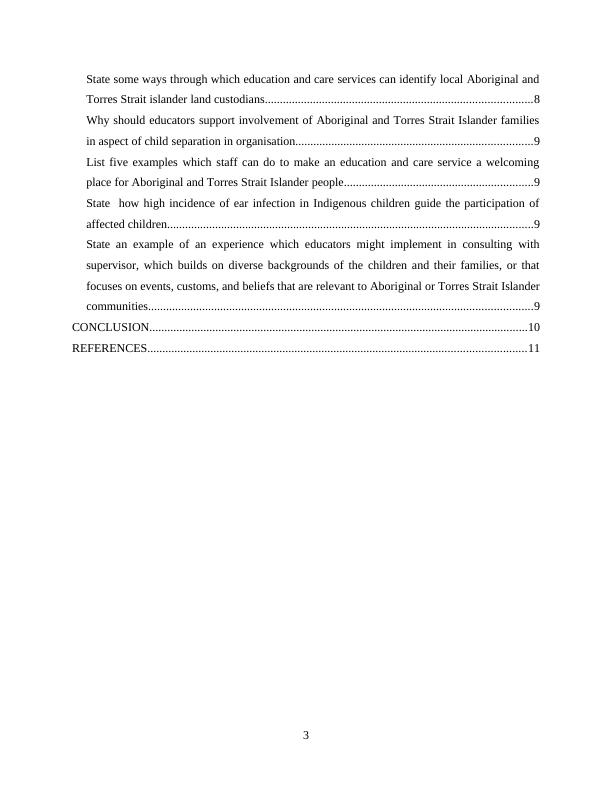Developing Cultural Competence: Aboriginal and Torres Strait Islander People
Added on 2022-12-26
11 Pages3221 Words71 Views
DEVELOP CULTURE
COMPETENCE
1
COMPETENCE
1

Table of Contents
INTRODUCTION...........................................................................................................................4
QUESTIONS...................................................................................................................................4
How Australian Government define an Aboriginal or Torres Strait Islander person.................4
Determine aspects of environment which can influence cultural identity..................................4
State experiences which people experience when they move to new country and how it can
affect well being..........................................................................................................................4
Define cultural disconnect and provide an example...................................................................5
Explain cultural competencies....................................................................................................5
Explain cultural awareness..........................................................................................................5
Explain cultural sensitivity..........................................................................................................5
Explain cultural safety.................................................................................................................6
State the importance of reviewing curriculum, resources and activities regularly.....................6
State five qualities or skills which a culturally competent person have.....................................6
State some experiences which a staff can provide to children's to explore diversity.................6
When observing a child closely, what signs staff might use through which they can identify
the need of additional support.....................................................................................................7
State different types of information which can be gathered for identifying cultural identities of
children's within service, families and community.....................................................................7
How should we communicate and interact with children which can help people to work
towards a strong sense of identity and well-being......................................................................7
SCENARIO......................................................................................................................................7
Describe family composition which is generally experienced with Indigenous households and
explain how this might compare to your own.............................................................................7
ASSESSMENT TASK 2.................................................................................................................8
What knowledge is important to have about history of Aboriginal and Torres Strait Islander
People..........................................................................................................................................8
State the meaning of Stolen Generation......................................................................................8
What were and continue to be effects of the Stolen Generation on Aboriginal people..............8
2
INTRODUCTION...........................................................................................................................4
QUESTIONS...................................................................................................................................4
How Australian Government define an Aboriginal or Torres Strait Islander person.................4
Determine aspects of environment which can influence cultural identity..................................4
State experiences which people experience when they move to new country and how it can
affect well being..........................................................................................................................4
Define cultural disconnect and provide an example...................................................................5
Explain cultural competencies....................................................................................................5
Explain cultural awareness..........................................................................................................5
Explain cultural sensitivity..........................................................................................................5
Explain cultural safety.................................................................................................................6
State the importance of reviewing curriculum, resources and activities regularly.....................6
State five qualities or skills which a culturally competent person have.....................................6
State some experiences which a staff can provide to children's to explore diversity.................6
When observing a child closely, what signs staff might use through which they can identify
the need of additional support.....................................................................................................7
State different types of information which can be gathered for identifying cultural identities of
children's within service, families and community.....................................................................7
How should we communicate and interact with children which can help people to work
towards a strong sense of identity and well-being......................................................................7
SCENARIO......................................................................................................................................7
Describe family composition which is generally experienced with Indigenous households and
explain how this might compare to your own.............................................................................7
ASSESSMENT TASK 2.................................................................................................................8
What knowledge is important to have about history of Aboriginal and Torres Strait Islander
People..........................................................................................................................................8
State the meaning of Stolen Generation......................................................................................8
What were and continue to be effects of the Stolen Generation on Aboriginal people..............8
2

State some ways through which education and care services can identify local Aboriginal and
Torres Strait islander land custodians.........................................................................................8
Why should educators support involvement of Aboriginal and Torres Strait Islander families
in aspect of child separation in organisation...............................................................................9
List five examples which staff can do to make an education and care service a welcoming
place for Aboriginal and Torres Strait Islander people...............................................................9
State how high incidence of ear infection in Indigenous children guide the participation of
affected children..........................................................................................................................9
State an example of an experience which educators might implement in consulting with
supervisor, which builds on diverse backgrounds of the children and their families, or that
focuses on events, customs, and beliefs that are relevant to Aboriginal or Torres Strait Islander
communities................................................................................................................................9
CONCLUSION..............................................................................................................................10
REFERENCES..............................................................................................................................11
3
Torres Strait islander land custodians.........................................................................................8
Why should educators support involvement of Aboriginal and Torres Strait Islander families
in aspect of child separation in organisation...............................................................................9
List five examples which staff can do to make an education and care service a welcoming
place for Aboriginal and Torres Strait Islander people...............................................................9
State how high incidence of ear infection in Indigenous children guide the participation of
affected children..........................................................................................................................9
State an example of an experience which educators might implement in consulting with
supervisor, which builds on diverse backgrounds of the children and their families, or that
focuses on events, customs, and beliefs that are relevant to Aboriginal or Torres Strait Islander
communities................................................................................................................................9
CONCLUSION..............................................................................................................................10
REFERENCES..............................................................................................................................11
3

INTRODUCTION
Aboriginal people are those who belong to mainland Australia. Torres Strait Islander
people are beings who lives in 274 islands of north of Australia, in the Torres Strait. This project
report is based on developing cultural competencies and throws a light on Aboriginal or Torres
Strait Islander people (Blackburn, 2015). This report also states family composition which can be
experienced in Indigenous households.
QUESTIONS
How Australian Government define an Aboriginal or Torres Strait Islander person
Aboriginal people have long and contentious history in Australia and are a part of
Aboriginal race of Australia. The Australian government have defined Aboriginal or Indigenous
person as people who are descendants of indigenous inhabitant of Australia or are members of
this race in Australia. Torres Strait Islander person are those people who come from islands of
Torres Strait which is situated between Cape York in Queensland and Papua New Guinea. These
people are of Melanesian origin and have different identities, histories and cultural traditions
than Aboriginal people of Australia.
Determine aspects of environment which can influence cultural identity
Cultural identity is a human trait or personality of a person which is related to person's
physical and social environment (Boroughs and et.al, 2015). Cultural identities makes a person
and family unique. In other words, it can be stated as linguistic identity and how language and
culture makes a person different. If there are any changes in environment, it can also be a
responsible factor which can change the culture. The aspects which create an influence on
cultural identity of people are customs, family traditions religion, music or language are some of
the responsible factors.
State experiences which people experience when they move to new country and how it can affect
well being
When moving to a new country it can create a positive as well as negative impact on a
person's life, as it creates a opportunity for person to travel to different location, grab knowledge
about different cultures, value and beliefs. This also help in learning, gaining more knowledge,
and in personal growth as this can enhance personality of a person through observing and
4
Aboriginal people are those who belong to mainland Australia. Torres Strait Islander
people are beings who lives in 274 islands of north of Australia, in the Torres Strait. This project
report is based on developing cultural competencies and throws a light on Aboriginal or Torres
Strait Islander people (Blackburn, 2015). This report also states family composition which can be
experienced in Indigenous households.
QUESTIONS
How Australian Government define an Aboriginal or Torres Strait Islander person
Aboriginal people have long and contentious history in Australia and are a part of
Aboriginal race of Australia. The Australian government have defined Aboriginal or Indigenous
person as people who are descendants of indigenous inhabitant of Australia or are members of
this race in Australia. Torres Strait Islander person are those people who come from islands of
Torres Strait which is situated between Cape York in Queensland and Papua New Guinea. These
people are of Melanesian origin and have different identities, histories and cultural traditions
than Aboriginal people of Australia.
Determine aspects of environment which can influence cultural identity
Cultural identity is a human trait or personality of a person which is related to person's
physical and social environment (Boroughs and et.al, 2015). Cultural identities makes a person
and family unique. In other words, it can be stated as linguistic identity and how language and
culture makes a person different. If there are any changes in environment, it can also be a
responsible factor which can change the culture. The aspects which create an influence on
cultural identity of people are customs, family traditions religion, music or language are some of
the responsible factors.
State experiences which people experience when they move to new country and how it can affect
well being
When moving to a new country it can create a positive as well as negative impact on a
person's life, as it creates a opportunity for person to travel to different location, grab knowledge
about different cultures, value and beliefs. This also help in learning, gaining more knowledge,
and in personal growth as this can enhance personality of a person through observing and
4

End of preview
Want to access all the pages? Upload your documents or become a member.
Related Documents
Becoming A Social Worker | Assessmentlg...
|14
|3074
|36
We need to choose a topiclg...
|4
|331
|26
Comparing Groups: Aboriginal and Torres Strait Islander People and LGBT Community in Australialg...
|10
|2837
|448
Comparing group assignment PDFlg...
|10
|2813
|110
Two Historical Issues Impacting Aboriginal and/or Torres Strait Islander Peoplelg...
|4
|1145
|133
First Nation Education Assignment 2022lg...
|7
|2311
|15
